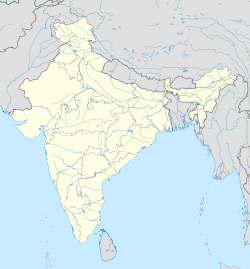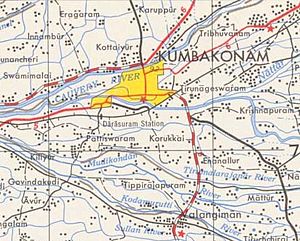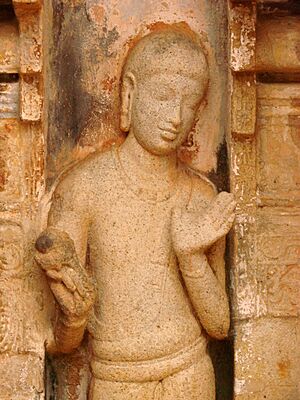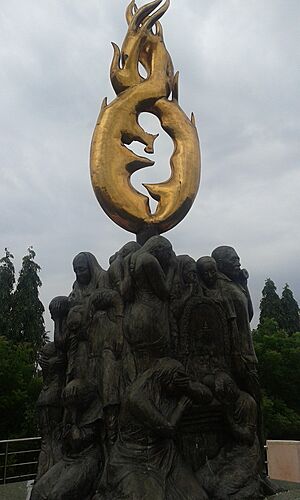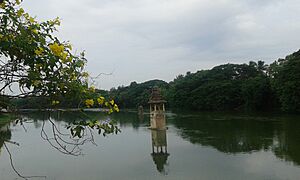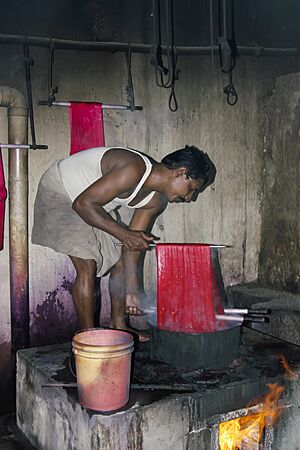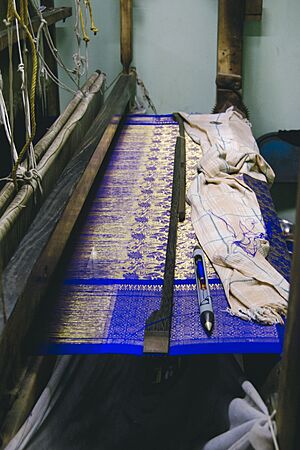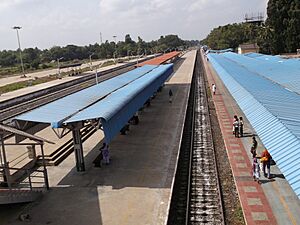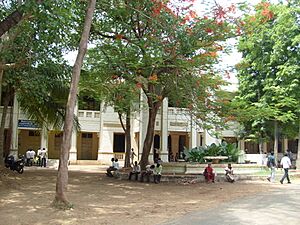Kumbakonam facts for kids
Quick facts for kids
Kumbakonam
Kudandhai
|
|
|---|---|
|
City Municipal corporation
|
|
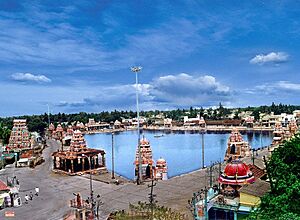 |
|
| Nickname(s):
Temple city
|
|
| Country | |
| State | Tamil Nadu |
| District | Thanjavur District |
| Region | Cauvery Delta |
| Government | |
| • Type | City Municipal Corporation |
| • Body | Kumbakonam municipal corporation |
| Area | |
| • Total | 42.95 km2 (16.58 sq mi) |
| Elevation | 53 m (174 ft) |
| Languages | |
| • Official | Tamil |
| Time zone | UTC+5:30 (IST) |
| PIN |
612001-6
|
| Telephone code | (91) 435 |
| Vehicle registration | TN 68 |
Kumbakonam is a city in the Thanjavur district of Tamil Nadu, India. It is also known as Kudanthai. The city is about 40 km (25 mi) from Thanjavur and 282 km (175 mi) from Chennai. It is the second largest city in its district.
Two rivers surround Kumbakonam: the Kaveri River to the north and the Arasalar River to the south. Kumbakonam is famous as a "Temple town" because it has many temples. It is also known for its Mahamaham festival, which happens every 12 years. This festival brings people from all over India to the city.
Kumbakonam has a long history, dating back to ancient times. Many different kingdoms ruled it, including the Early Cholas, Pallavas, Pandyas, and the Vijayanagara Empire. During the British Raj, it became an important center for education and Hindu culture. It was even called the "Cambridge of South India". In 1866, Kumbakonam became a municipality. On August 24, 2021, it became a city municipal corporation.
Contents
What's in a Name?
The name "Kumbakonam" means "Pot's Corner" in English. This name comes from an old story in Hinduism. It is believed that the god Brahma had a special pot (kumbha) that held the seeds of all living things. This pot was carried away by a great flood (pralaya) and landed where Kumbakonam is today.
This event is remembered during the Mahamaham festival, which takes place every 12 years. In ancient times, Kumbakonam was also known as Kudanthai or Kudamukku. The British used to spell it as Coombaconum.
A Look Back in Time
People lived in the area around Kumbakonam as early as the Sangam Age (around 3rd century BC to 3rd century AD). Some historians believe that ancient Kudavayil, where the Early Chola king Karikala held his court, was located here.
Kumbakonam became very important during the rule of the Medieval Cholas (9th to 12th centuries). The town of Pazhaiyaarai, about 8 km (5 mi) from Kumbakonam, was the capital of the Chola Empire in the 9th century.
After the Chola kingdom declined, the Pandyas took over Kumbakonam in 1290. Later, the Vijayanagar Empire ruled the city. Krishnadevaraya, a famous emperor, visited in 1524. He is said to have bathed in the famous Mahamaham tank during the festival.
The city was then ruled by the Madurai Nayaks and Thanjavur Nayaks, and later by the Thanjavur Marathas. Each of these rulers influenced the people and culture of the area. When the Vijayanagar Empire fell in 1565, many artists and musicians moved to Kumbakonam.
In the late 1700s, Kumbakonam faced difficulties due to invasions. However, it recovered by the early 1800s. In 1799, the city was given to the British East India Company. It became very successful in the late 19th and early 20th centuries. It was a major center for Hindu religion and European education.
Railway lines were built in 1877, connecting Kumbakonam to important ports. This helped trade and growth. Even after India became independent, Kumbakonam continued to grow.
Where is Kumbakonam?
Kumbakonam is located at 10.97°N 79.42°E. It is about 273 km (170 mi) south of Chennai. The city is in the "Old delta" region. This area has been naturally watered by the Cauvery River and its branches for many centuries.
The city is about 26 meters (85 ft) above sea level. The Cauvery River is to the north, and the Arasalar River is to the south.
Even though the Cauvery delta can be hot, Kumbakonam usually has a healthy and mild climate. Summers can reach about 40°C (104°F), and winters are around 20°C (68°F). The city gets about 114.78 cm (45.19 in) of rain each year. The soil is mostly rich and black, which is great for growing rice. Other crops like sugarcane are also grown here.
People of Kumbakonam
| Religious census | ||||
|---|---|---|---|---|
| Religion | Percent(%) | |||
| Hindu | 86.07% | |||
| Muslim | 9.57% | |||
| Christian | 3.99% | |||
| Sikh | 0.0% | |||
| Buddhist | 0.0% | |||
| Jain | 0.23% | |||
| Other | 0.13% | |||
| Historical population | ||
|---|---|---|
| Year | Pop. | ±% |
| 1871 | 44,444 | — |
| 1881 | 50,098 | +12.7% |
| 1891 | 54,307 | +8.4% |
| 1901 | 59,673 | +9.9% |
| 1911 | 64,647 | +8.3% |
| 1921 | 60,700 | −6.1% |
| 1931 | 62,317 | +2.7% |
| 1941 | 67,008 | +7.5% |
| 1951 | 91,648 | +36.8% |
| 1961 | 92,581 | +1.0% |
| 1971 | 113,130 | +22.2% |
| 1981 | 132,832 | +17.4% |
| 1991 | 139,449 | +5.0% |
| 2001 | 140,021 | +0.4% |
| 2011 | 140,056 | +0.0% |
Sources:
|
||
In 2011, Kumbakonam had a population of 140,156 people. There were more females than males, with 1,021 females for every 1,000 males. The city's average literacy rate was 83.21%, which is higher than the national average.
Most people in Kumbakonam are Hindus. There are also many Muslims and Christians. The main language spoken is Tamil. Some people also speak Thanjavur Marathi, Telugu, Kannada, and Saurashtra.
About 32% of the city's area is for homes. Businesses take up about 2.75%, and factories take up 1.21%.
What Kumbakonam Makes and Does
Kumbakonam is known for making many things. These include items made of brass, bronze, copper, and pewter. It also produces silk and cotton clothes, sugar, and pottery. It is a major business center for the Thanjavur region.
Growing rice is a big part of the economy. Many rice and flour mills are in the city. Kumbakonam is also famous for its betel leaves and nuts, which are considered some of the best in the world.
The city is an important center for metal work. There's even a special center nearby to train bronze artists. Silk weaving is another major industry, with thousands of families involved. The silk made here is very fine and used for beautiful Thirubuvanam silk sarees.
Kumbakonam is also known for its special blend of coffee, called Kumbakonam Degree Coffee. In recent times, the city has also become a key producer of fertilizers.
Besides manufacturing, tourism is a big source of income. Many hotels and resorts are available for visitors. The ancient Hindu temples and old colonial buildings attract many tourists. The 12th-century Airavatesvara Temple in Darasuram, near Kumbakonam, is a UNESCO World Heritage Site. This temple, along with two others, is known as one of the Great Living Chola Temples.
Many banks have branches in Kumbakonam. The City Union Bank was even founded here in 1904.
City Services
Kumbakonam gets its electricity from the Tamil Nadu Electricity Board (TNEB). Water is supplied by the Kumbakonam municipality from the Cauvery and Coleroon rivers.
The city collects about 18 metric tons of waste every day. This waste is sorted to make organic fertilizer. Kumbakonam also has some underground drainage, and more is being built.
For communication, Kumbakonam is part of the Bharat Sanchar Nigam Limited (BSNL) network. BSNL provides phone and internet services. The city has a district hospital, many private hospitals, and clinics to meet healthcare needs.
Famous Places
Temples and Holy Sites
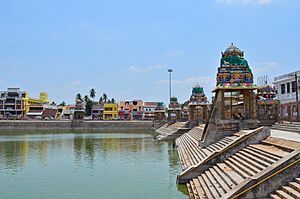
Kumbakonam is famous for its many temples and mathas (monasteries). There are nearly 200 Hindu temples within the city limits. This is why it's called "Temple Town" or "City of temples."
- The Adi Kumbeswarar Temple is believed to be the oldest Shaiva (dedicated to the god Shiva) temple in the city. It was likely built by the Cholas in the 7th century.
- The Nageswaraswamy Temple has a special shrine for the Sun god Surya.
- The Sarangapani temple is the largest Vaishnava (dedicated to the god Vishnu) temple in Kumbakonam. Its tall, twelve-story tower was built by Nayak kings in the 15th century. It is one of the 108 special Vishnu temples called "Divya Desams."
- The Ramaswamy temple shows scenes from the Hindu epic Ramayana on its walls.
A very important event is the Mahamaham festival. Every 12 years, millions of pilgrims come to take a holy dip in the Mahamaham tank. This festival is also known as the Southern Kumbha Mela.
Kumbakonam also has several mathas, which are centers for religious learning and spiritual practice.
The Airavatesvara Temple in Darasuram, near Kumbakonam, is a UNESCO World Heritage Site. It was built by Rajaraja Chola II in the 12th century.
Getting Around
Kumbakonam is well-connected by roads and railways. National Highway NH-36 passes through the city. The closest international airport is in Tiruchirapalli, about 91 km (57 mi) away. The nearest seaport is Nagapattinam, about 50 km (31 mi) away.
The city has a good network of roads. There are regular government and private bus services connecting Kumbakonam to many cities in Tamil Nadu and even to Bengaluru and Mysuru.
Kumbakonam is also connected by train to major cities like Chennai, Coimbatore, and Madurai. There are also local passenger trains to nearby towns.
In the past, people used bullock carts for travel. While still used, buses and motor vehicles are now more common. There is also a local bus system within the city.
Learning in Kumbakonam
Kumbakonam has a long history of education. It was even called the "Cambridge of South India" in the late 19th century.
The Raja Veda Padasala, founded in 1542, teaches ancient Sanskrit scriptures.
The Government Arts College, established in 1867, is one of the oldest colleges in the region. It became a government college in 1867 and was linked to the Madras University in 1877. Famous people like the Indian mathematician Srinivasa Ramanujan studied here.
There is also a Government Arts College for Women, started in 1963. Many other colleges in Kumbakonam offer various courses in arts, sciences, and engineering.
Some of the oldest schools in the area, like the Native High School (founded in 1876) and the Town Higher Secondary School, are also in Kumbakonam. Today, the city has many government and private schools.
See also
 In Spanish: Kumbakonam para niños
In Spanish: Kumbakonam para niños



